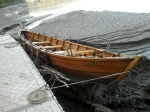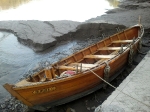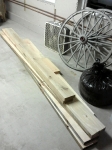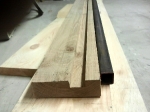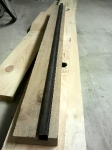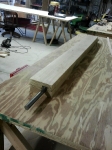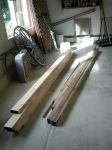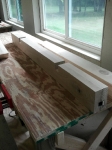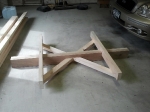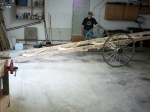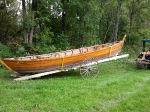Our bateaux get stuck on an empty river bed
Since the hurricane on the 28 of August, the boats have been tied up at the dock. Unfortunately, the river level has fallen dramatically because the river cut a new channel around Lock 8, and the pool height is no longer being maintained.
On several days we tried to get together to get the boats out of the river. First the river was far too high, then far too low. There are two boat ramps between Lock 8 and Lock 9. The public ramp is covered in a vast quantity mud and is officially closed. Even if we could bypass the danger tape, we still would need a bulldozer to clear enough mud to allow a truck to get down to the ramp and back. The private ramp is even worse — a huge berm of mud prevents getting a trailer anywhere close to the water.
The fate of the boats (and the dock) has been preying on our minds. The boats weren’t in any immediate danger, but they were definitely not situated in a good position. With erosion or heavy rains, the dock could break and the boats could be injured. All sorts of silly-season suggestions were floated about, but none of them made more sense than just using grunt labor.
A bateau wagon might help
I thought that, in addition to grunt labor, a period bateau-wagon would facilitate moving the boats. I have boat wagon illustrations in Diderot and St. Remy, both of which show a hay-cart like wagon with the boat either upside up or upside down on it. These wagons have two axles — one with large wheels in the back and one with smaller wheels at the front, with the smaller wheels part of a steering mechanism that I don’t quite understand. These wagons are generally intended for ox-hauling.
I also have an 18th century drawing showing, instead, a wagon with a single central axle and a fixed bed (no steering mechanism). This was used on the coast of France on tidal flats, and the picture shows a wheel that is 6 or 8 feet in diameter. These wagons are intended for man-hauling.
Not having oxen, and, more importantly, only having a single set of wheels (the old cannon carriage wheels), I decided to build a somewhat period single-axle bateau wagon. I mulled over various plans and eventually decided on a long frame with a single axletree. The frame is reinforced with diagonal braces (I see many references to ladder-like bracing, but that involved more mortises and tenons that I have the patience and time to cut).
Building the bateau wagon
Based on my wood stores, the axletree was made of white oak and the rest of the wagon out of pine, all rough-cut air-dried lumber. Kevin went to the Metal Supermarket and obtained an axle and a square shaft. I set to work.
The axletree is 5′ 8″ across, a distance I deemed appropriate to let the wider of the two boats (the Bobbie G) ride without any danger of rubbing on the wheels. I probably could have made it 4 inches narrower, but wanted to err on the side of safety. I used two 2″ x 6″ pieces of oak, which, once joined and planed, ended up with a finished dimension of around 3 1/2″ x 5 3/4″. I cut a dado in each piece for the axle channel, sandwiched the two pieces together, attached them with trunnels, and planed the whole thing square.
To the axle tree I attached two short (48″) arms with diagonal bracing. On each side I attached two long arms (around 10′ — I just used the length of wood I had), also with diagonal bracing. The outside-to-outside dimension of the arms was 34″. The arms were roughly 1 3/4″ x 4 1/2″, and the bracing was roughly 1 3/4″ x 3″. These dimensions were chosen purely based on the wood I had on hand.
The two long sides were attached to the axletree assembly with carriage bolts. At each end I affixed eye bolts.
With Kevin’s help, I managed to make the whole wagon in three evenings and one Saturday. It was designed to come apart into three pieces (plus the two wheels) so I could transport it from home to the Farm. I’m sure a true 18th century wagon would have used single pieces of timber for the rails.
I should note that Kevin did a fair amount of work to get the axle to fit with the old wheels. We used an odd assortment of washers to compensate for the strange wheel hubs.
Using the bateau wagon on a muddy river bed
Today, we tried out the bateau wagon in earnest. Kevin helped me transport the pieces to the farm. We assembled it there. I still didn’t know how much it would be helpful versus how much of a folly I had just created — I feared that 16 hours of woodworking might result in just another item stuck in the mud.
We had six people helping today: Harvey, Allison, Gary, Jonathan, Kevin, and myself. It was just barely enough; we would have loved to have a few more.
Gary made sure the road through the woods was clear with the farm tractor. The rest of us rolled the wagon down to the river bed. We stripped the DeSager of all removable items: oars, mast, thwarts, anchor, fenders, PFDs, etc. We unmade the mooring lines from the dock.
With effort we positioned the wagon where we though it would be most useful. Unfortunately, there was a massive mud bank that prevented us from moving the DeSager on to the wagon easily. We shoveled away some of the mud, then partially disassembled the dock so as to get enough clearance for the boat. We wrestled the DeSager onto the wagon and secured it with the trailer straps. In the process we managed to partially tear off one of the landing skids; this is a sacrificial piece of oak designed to protect the bottom when you drag the boat around.
We now had to wheel the boat and wagon across the mud some 300 yards, then swing the boat up the sloped river bed and into the woods. This was much easier said than done. The wheels sunk in the mud to various degrees depending on how soft the mud was and how deep down the stone river bed was under the mud.
It would have been wonderful to go a short distance, but we needed to get to a point where the bank wasn’t too steep. We also had to navigate around some 4 or 5 foot deep gullies that had been washed in the mud.
We had two people pulling, one person on each wheel, and two people pushing. When the wheels only sank a few inches, the movement wasn’t bad. When one wheel sank a foot, it still wasn’t too awful. However, when one wheel was 15″ deep and the other 8″ in, it was arduously dreadful.
We used a variety of scrap boards to get over the softest of the mud. The wagon rolled quite well on boards (it would be a snap on a hard surface), but we spent a great amount of effort forwarding boards ahead. Everything was made harder by us sinking in the mud, sometimes to the knee.
After much toil we got the boat up the river bed and into the woods. At this point we secured a rope from the wagon to the farm tractor. We couldn’t get the tractor too close as there was a deep pit of mud in the way. We had one spot where the axle and wheels of the wagon had perhaps 2 inches of clearance between two trees.
Once we were across the mud pit, we hooked the wagon to the tractor using a chain and then towed the wagon out of the woods. This was a goodly distance, but comparatively easy, as the ground was pretty solid.
We got the DeSager up into the farm yard, whereupon we transferred it to the flatbed trailer and put it away. Aside from the damaged skid, a success.
The second boat
After this we needed to move the Bobbie G. We pumped out the rain water, removed the oars, mast, and other gear, and unmade the mooring lines.
Rather than travel the 300 yards across the mud flats, we decided to slide and drag the boat down to the water and wade it up to a location opposite to the road into the woods. This went okay, barring the frequent occurrence of someone sinking in the mud.
Getting the Bobbie G on to the wagon was a struggle. We spent a half hour or more wrestling it with all of our might. We eventually got it on the wagon and strapped down. My muscles ache just thinking about it.
Gary had rigged a pulley and a very long rope so that the tractor could help pull the wagon up the river bed. We put down boards to help the wagon and boat stay above the mud. This worked just fine until we got to the edge of the woods.
We manually grunted the boat and wagon up the short bank. We first had to roll backwards to get on boards, as we had lost the strength to get the wagon out of the mud and up hill at the same time. Once on boards we got up the bank without any mishap.
Once more we attached the line to the tractor (now a direct line, rather than around a pulley). Again, we had to navigate between the tight trees and the mud pit. Again, once we were through that we were able to hook the tractor to the wagon with the chain and then let the tractor do the hard work.
Overall, a success. We did make one gouge in the Bobbie G‘s side.
Conclusion
The bateau wagon worked. It was the right tool for the job. If I had to make another one, I would make some modifications, however. First, I would make the cross-bracing so that it was level with the rails. This would make loading the bateau much easier and less prone to damage. Second, I would have used slightly stouter rails, as these seemed close to the limit of their durability. Considering how hard we pulled on things, it was a complete success; I just doubt that the wagon would withstand many of these uses.
I’m impressed with how well the old cannon wheels held up to the rigors of the day. At several times I thought we were applying a significant lateral force that could have snapped something. The wheel maker should be commended.
Lastly, a huge thanks to all those who helped.
Videos require flash to play. Thanks to Heather for some of the photographs and the videos.
Finishing placing the Bobbie G on to the wagon
The tractor begins to pull the Bobbie G up the beach
At the river bank
Pulling the wagon with Bobbie G through the woods
Back on level, open ground at last
Towing the boat to a reasonable storage spot
